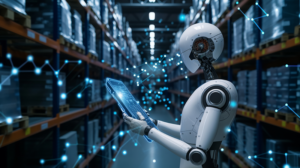Artificial intelligence (AI) is the present and future of technology. But how can we use this tool to optimize the supply chain?
AI opens many scenarios to discover and offers the possibility of exploring new business opportunities to grow your profitability; and achieve sustainability. One example: combining AI with the use of machine learning to collect data and produce forecasts.
Artificial intelligence consists of emulating human intelligence by machines and computer systems. The goal is to create machines that can act like people, something that sounded like science fiction a few years ago, but is becoming reality.
The term artificial intelligence was a creation by the American scientist John McCarthy in 1956. However, Alan Turing had already raised the question of whether machines could ever think like humans through the Turing test. This is a criterion by which a machine’s intelligence can be judged based on whether its responses are similar or discernible to those of a human being.
By applying AI to the world of software, it can change its behavior without being specifically programmed to do so. To do this, AI has deep neural networks (DNN) that analyze complex information such as videos, images, and data sets to decide, detect, and predict based on the data received.
Based on collected data, analysis, and observation; AI systems can identify patterns, make reliable predictions, and operate unattended in certain scenarios. AI is very useful in many fields, such as computer vision or automatic voice recognition.
Three factors that have fostered the development of artificial intelligence:
Unlimited access to processing power. The cloud has been the driver of data intelligence because of its flexibility, elasticity, and efficiency, both in storage space, speed, and security of managing and controlling that data.
The rise of data intelligence (big data). This is not just about storing a large volume of information, but also about managing and exploiting it
The proliferation of specialized hardware in the enhancement of artificial intelligence such as GPU Computing, FGPA, or TPU. These are much faster and more advanced tools for analyzing data.
One of the premises of artificial intelligence is to ensure that production processes are increasingly efficient.
How to apply artificial intelligence
The application of AI, both in our daily lives and in the world of work, is a rising phenomenon. 24 percent of organizations have increased their investments in artificial intelligence and 42 percent have remained unchanged since the onset of the COVID-19 pandemic.
Enterprise investment in AI has continued unabated despite the crisis. Furthermore, 79% of the organizations are exploring AI projects, while only 21% are in the production stage.
So far, most companies have opted for automation to enhance their development. Recent developments in AI, however, highlight that companies must go a step further and unleash the potential of machine intelligence if they want to differentiate themselves from their competitors.
7 main steps
The best way to start applying artificial intelligence is to map out a strategic plan that adds value to the business, considering the following steps:
1 – Select the fields of application. The first step is to make a list of the fields where it would be possible to apply this technology. To do this, we must identify who is the expert for each use case and verify the existence of valid data sources, as well as performance metrics (KPIs) that provide objective data on progress.
2 – Prioritize the application fields. Estimate the value that each of the identified cases has to the business; as well as anticipate what possible difficulties may arise in applying AI (Such as the absence of adequate data or the impossibility of targeting improvements). Radical changes should not be tackled until progressive improvements are applied to existing processes. The definition of use cases occurs according to their importance to the business.
3 – Group the application fields. It is advisable to group the application fields according to the data that feeds them so that they work together.
4 – Implement. It is preferable to do it with a partner who has technological experience in the area.
5 – Evaluate. Determine from test data sets whether the KPI metrics to be improved are doing so with the AI prototype application.
6 – Launch. Once the solution has been successfully evaluated, it should be launched in a controlled manner to verify that what has been achieved in testing matches reality. In other words, check that the system adapts correctly to the data received from the real environment.
7 – Full implementation. Consists of launching the system extensively to move on to the next set of application fields.
One Solution
At Grydd we apply artificial intelligence to your supply chain with our smart operating system focused on technological innovation in logistics. Check out all we can do for you right here.


















